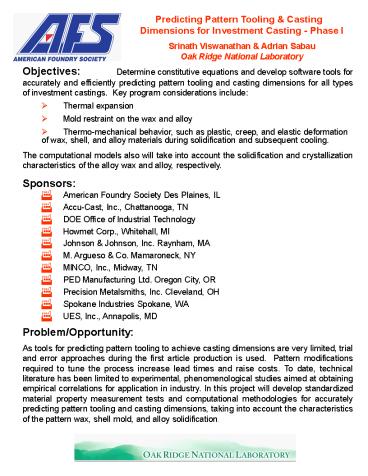Predicting Pattern Tooling PowerPoint PPT Presentation
1 / 2
Title: Predicting Pattern Tooling
1
Predicting Pattern Tooling Casting
Dimensions for Investment Casting - Phase
I Srinath Viswanathan Adrian Sabau Oak Ridge
National Laboratory
- Objectives Determine constitutive
equations and develop software tools for
accurately and efficiently predicting pattern
tooling and casting dimensions for all types of
investment castings. Key program considerations
include - Thermal expansion
- Mold restraint on the wax and alloy
- Thermo-mechanical behavior, such as plastic,
creep, and elastic deformation of wax, shell, and
alloy materials during solidification and
subsequent cooling. - The computational models also will take into
account the solidification and crystallization
characteristics of the alloy wax and alloy,
respectively. - Sponsors
- American Foundry Society Des Plaines, IL
- Accu-Cast, Inc., Chattanooga, TN
- DOE Office of Industrial Technology
- Howmet Corp., Whitehall, MI
- Johnson Johnson, Inc. Raynham, MA
- M. Argueso Co. Mamaroneck, NY
- MINCO, Inc., Midway, TN
- PED Manufacturing Ltd. Oregon City, OR
- Precision Metalsmiths, Inc. Cleveland, OH
- Spokane Industries Spokane, WA
- UES, Inc., Annapolis, MD
- Problem/Opportunity
- As tools for predicting pattern tooling to
achieve casting dimensions are very limited,
trial and error approaches during the first
article production is used. Pattern
modifications required to tune the process
increase lead times and raise costs. To date,
technical literature has been limited to
experimental, phenomenological studies aimed at
obtaining empirical correlations for application
in industry. In this project will develop
standardized material property measurement tests
and computational methodologies for accurately
predicting pattern tooling and casting
dimensions, taking into account the
characteristics of the pattern wax, shell mold,
and alloy solidification.
2
- Action/Implementation
- Guidelines for pattern handling are currently
available but cannot be used to predict wax
deformation. Phase I focuses on measuring wax
properties and predicting wax pattern dimensions
based on thermal expansion/contraction and
viscoelastic properties of the wax during its
crystallization and subsequent cooling. - Models that seek to predict investment casting
and tooling dimensions must include heat
transfer, solidification, stress build-up due to
the restraint of wax and alloy geometrical
features. Thermo-mechanical properties of the
alloy (elastic, viscoplastic) and wax
(viscoelastic) must be considered. - Pressure and temperature measurements can be used
to determine the maximum dwell time and the onset
of gate freezing. - Temperature data near the die interface was used
to estimate the heat transfer coefficient
Test methods used to characterize polymeric
materials were used to quantify wax deformation
properties. Stepped wax patterns, with and
without mold restraint, were made. Analysis
procedures for computing the wax dimensions were
developed.
Shrinkage cm
- The shrinkage factor is dimension dependent.
- Shrinkage of the pattern length is larger for the
restrained pattern. - There is a good agreement between experimental
data and numerical simulation results of wax
pattern distortion.
Future Potential The development of constitutive
equations for wax, shell, and alloy materials
based on experimental measurements will provide a
sound base for casting packages. Future efforts
will focus on filled waxes, shell, and alloy
materials. To facilitate adoption by industry,
tutorials on the use of investment casting models
for production castings will be developed.
Workshops will be conducted for industry sponsors
and the results will be disseminated through
trade press and industry conferences. For more
information visit http//www.ms.ornl.gov/research
groups/process/PROCESS.HTM

